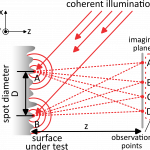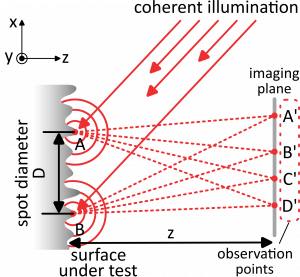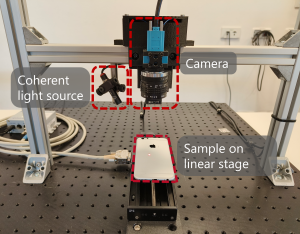
Principles for In-Plane Motion Sensing and Tracking (iTRACK)
Project focus
- Development of correlation-based in-plane sensing principles
- Development of interferometric in-plane sensing principles
- Implementation of real-time capable measurement algorithms and hardware
- Integration of multi-sensor systems for in-plane displacement
Description
Distance and displacement are important physical quantities for positioning, sensing of object motion, vibration and deformations in various scientific and industrial areas such as non-destructive testing, as well as inline measurement systems. While there are various optical principles available for measuring out-of-plane (axial) displacement, the fast, robust and precise measurement of in-plane (lateral) displacement of arbitrary, non-structured technical surfaces on the sub-micrometer scale remains a largely unsolved challenge.
One of the stated goals of future high-tech manufacturing is to ensure 100% quality control of every good produced in order to meet global trends, such as resource efficient production. In this context, concepts for inline measurement systems are seen as key enabler for achieving the appointed targets. Still, one of the main challenges of future inline measuring systems is to perform measurments on the single to sub-micrometer scale in vibration-prone environments. Environmental disturbances are causing relative motion between the measurement tool and the sample, leading to corrupted measurements due to motion blur. One approach, to compensate for such motion is to actively track the sample surface, requiring sensing principles to measure out-of-plane as well as in-plane motion with bandwidths of several tens of kilohertz. However, the markerless sensing of in-plane motion on arbitrary technical surfaces with nanometer precision is still a largely unsolved challenge. A promising approach to markerless in-plane motion detection is to exploit the speckle effect of coherent light sources, such as lasers. The speckle effect is an optical interference phenomenon that forms a granular pattern on optically rough surfaces, such as metals or ceramics and is widely used for surface characterization, e.g., stress and strain analysis. Digital image correlation (DIC) techniques can be used to measure the in-plane motion of a sample as the speckle pattern or the speckle intensity shifts accordingly. The project will investigate the feasibility to measure in-plane motion with bandwidths of up to several tens of kiloherz aiming precision on the single nanometer scale.

Schematic depiction of the formation of laser speckles on an optically rough surface.

Setup to measure in-plane motion. A sample is placed on the sledge of a linear stage. A laser is used as the coherent light source, to form speckles on the optically rough surface. The in-plane motion can be detected by using DIC algorithms.
Applications
In-line metrology
Related publications
Zeitschriftenbeiträge
Konferenzbeiträge
Project partners
Funding